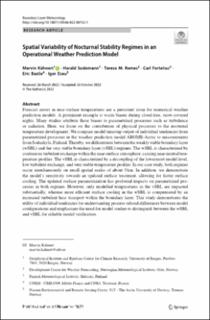| dc.contributor.author | Kähnert, Marvin | |
| dc.contributor.author | Sodemann, Harald | |
| dc.contributor.author | Remes, Teresa Maaria | |
| dc.contributor.author | Fortelius, Carl | |
| dc.contributor.author | Bazile, Eric | |
| dc.contributor.author | Esau, Igor | |
| dc.date.accessioned | 2022-12-29T14:40:36Z | |
| dc.date.available | 2022-12-29T14:40:36Z | |
| dc.date.created | 2022-11-24T13:19:18Z | |
| dc.date.issued | 2022 | |
| dc.identifier.issn | 0006-8314 | |
| dc.identifier.uri | https://hdl.handle.net/11250/3039940 | |
| dc.description.abstract | Forecast errors in near-surface temperatures are a persistent issue for numerical weather prediction models. A prominent example is warm biases during cloud-free, snow-covered nights. Many studies attribute these biases to parametrized processes such as turbulence or radiation. Here, we focus on the contribution of physical processes to the nocturnal temperature development. We compare model timestep output of individual tendencies from parametrized processes in the weather prediction model AROME-Arctic to measurements from Sodankylä, Finland. Thereby, we differentiate between the weakly stable boundary layer (wSBL) and the very stable boundary layer (vSBL) regimes. The wSBL is characterized by continuous turbulent exchange within the near-surface atmosphere, causing near-neutral temperature profiles. The vSBL is characterized by a decoupling of the lowermost model level, low turbulent exchange, and very stable temperature profiles. In our case study, both regimes occur simultaneously on small spatial scales of about 5 km. In addition, we demonstrate the model’s sensitivity towards an updated surface treatment, allowing for faster surface cooling. The updated surface parametrization has profound impacts on parametrized processes in both regimes. However, only modelled temperatures in the vSBL are impacted substantially, whereas more efficient surface cooling in the wSBL is compensated by an increased turbulent heat transport within the boundary layer. This study demonstrates the utility of individual tendencies for understanding process-related differences between model configurations and emphasizes the need for model studies to distinguish between the wSBL and vSBL for reliable model verification. | en_US |
| dc.language.iso | eng | en_US |
| dc.publisher | Springer | en_US |
| dc.rights | Navngivelse 4.0 Internasjonal | * |
| dc.rights.uri | http://creativecommons.org/licenses/by/4.0/deed.no | * |
| dc.title | Spatial variability of nocturnal stability regimes in an operational weather prediction model | en_US |
| dc.type | Journal article | en_US |
| dc.type | Peer reviewed | en_US |
| dc.description.version | publishedVersion | en_US |
| dc.rights.holder | Copyright 2022 the authors | en_US |
| cristin.ispublished | true | |
| cristin.fulltext | original | |
| cristin.qualitycode | 1 | |
| dc.identifier.doi | 10.1007/s10546-022-00762-1 | |
| dc.identifier.cristin | 2080100 | |
| dc.source.journal | Boundary-Layer Meteorology | en_US |
| dc.relation.project | Norges forskningsråd: 280573 | en_US |
| dc.identifier.citation | Boundary-Layer Meteorology. 2022. | en_US |

